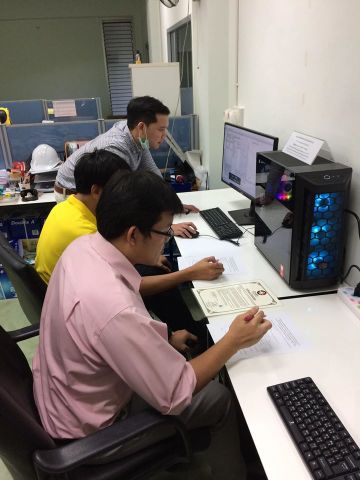In March 2020, Kalasin University took a significant step forward in architectural research with the implementation of scSTREAM software in the development of library design guidelines. Spearheaded by Miss Hassaya Sangsri, an instructor at the Innovative Design & Architecture department, this project highlights the integration of advanced computational tools to enhance the thermal efficiency and overall comfort of library spaces. The use of scSTREAM marked a pivotal moment in the university’s approach to architectural design, blending technology with sustainability to create optimized environments for learning and community engagement.
Table of Contents
Project Overview
The primary focus of Miss Hassaya Sangsri’s research was to develop comprehensive design guidelines for libraries, a critical space within academic institutions that demands both functionality and comfort. Libraries serve as hubs of knowledge, requiring environments that support long hours of study while ensuring thermal comfort and energy efficiency.
The research project aimed to address several key challenges:
- Thermal Comfort: Ensuring that library spaces maintain a consistent and comfortable temperature throughout the year, particularly in a region like Kalasin, where climate conditions can vary significantly.
- Energy Efficiency: Developing design strategies that minimize energy consumption, particularly in the heating, ventilation, and air conditioning (HVAC) systems, which are major contributors to a building’s energy use.
- User Experience: Creating an environment that is not only functional but also pleasant and conducive to prolonged study and research activities.
To achieve these objectives, Miss Hassaya and her team selected scSTREAM as the primary tool for their research. This decision was driven by scSTREAM’s robust capabilities in simulating thermal dynamics and fluid flow, making it an ideal choice for analyzing and optimizing the environmental conditions within a library setting.





scSTREAM Software Features
scSTREAM is a powerful thermo-fluid analysis software that has been serving the electronics and architectural industries for over three decades. Its popularity is largely due to its combination of user-friendly interfaces and high-speed processing capabilities, which make it accessible and efficient for both novice and experienced users.
Key features of scSTREAM include:
- Structured Mesh Technology: This allows for precise control over the grid size and resolution, enabling detailed simulations that capture the intricate dynamics of airflow and temperature distribution within a space.
- High-Speed Processing: scSTREAM is known for its ability to handle large-scale simulations quickly, which is essential in projects that require multiple iterations to fine-tune design parameters.
- Visual Outputs: The software generates high-quality visualizations that can be directly used in presentations and reports, making it easier to communicate findings to stakeholders and decision-makers.
In addition to scSTREAM, Miss Hassaya’s research also benefited from HeatDesigner, a derivative of scSTREAM specifically optimized for the thermal design of electronic products. While primarily used in electronics, HeatDesigner’s capabilities in managing heat distribution and optimizing cooling strategies proved to be invaluable in the architectural context as well.
These features made scSTREAM particularly beneficial in the architectural research conducted at Kalasin University, allowing Miss Hassaya and her team to explore various design scenarios with a high degree of accuracy and efficiency.
Application in Research
Miss Hassaya’s utilization of scSTREAM in her research on library design was groundbreaking. The software was used to simulate various environmental conditions within the library space, focusing on how different design elements—such as window placement, insulation materials, and HVAC system configurations—would impact the overall thermal comfort and energy efficiency of the building.
One of the most notable outcomes of the research was the discovery of optimal design configurations that balanced natural ventilation with mechanical cooling. By simulating airflow patterns and temperature gradients, the team was able to identify strategies that reduced the reliance on air conditioning, thereby lowering energy consumption while maintaining a comfortable indoor environment.
The use of scSTREAM also allowed for the exploration of innovative design concepts, such as the integration of passive cooling techniques and the strategic placement of thermal mass to absorb and release heat as needed. These concepts were then incorporated into the final design guidelines, providing a blueprint for future library projects that prioritize sustainability and user comfort.
The research process was further enhanced by the visual outputs generated by scSTREAM, which provided clear and compelling evidence of the effectiveness of the proposed design strategies. These visualizations were instrumental in securing support from university administrators and stakeholders, who could see firsthand the potential benefits of implementing the research findings.
Conclusion
The research conducted by Miss Hassaya Sangsri at Kalasin University underscores the vital role that advanced simulation tools like scSTREAM play in modern architectural design. By leveraging the powerful capabilities of scSTREAM, the research team was able to develop library design guidelines that not only meet the functional requirements of such spaces but also enhance thermal comfort and energy efficiency.
As educational institutions continue to prioritize sustainability and user-centric design, the use of tools like scSTREAM will undoubtedly become more prevalent. For those interested in learning more about scSTREAM and its applications across various industries, Cradle offers a wealth of resources and support for professionals looking to integrate advanced simulation into their projects.

